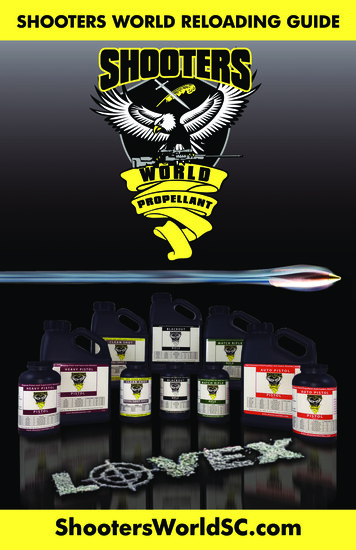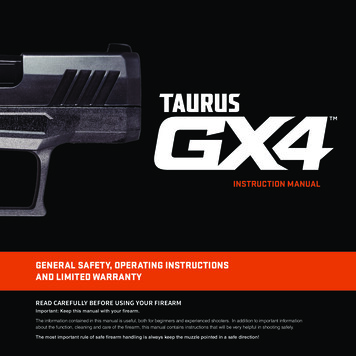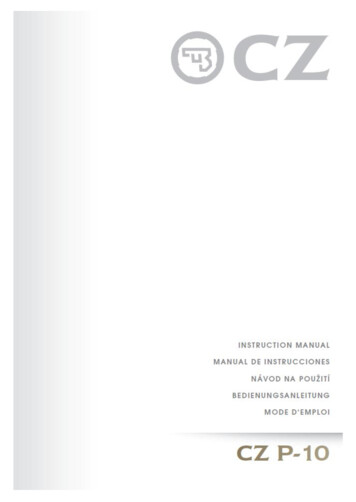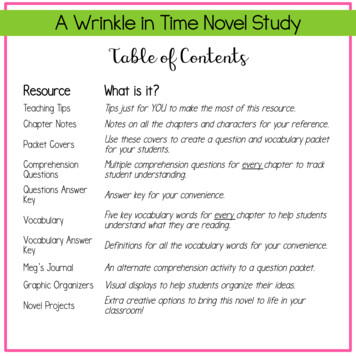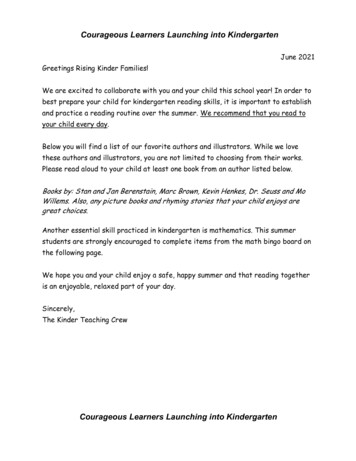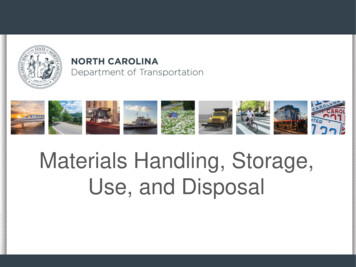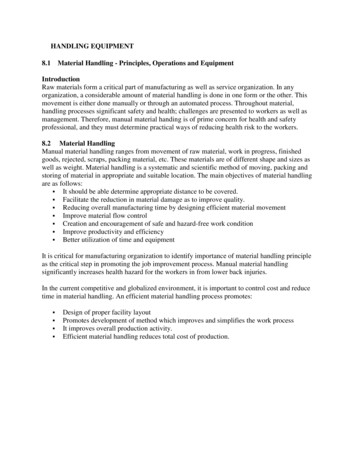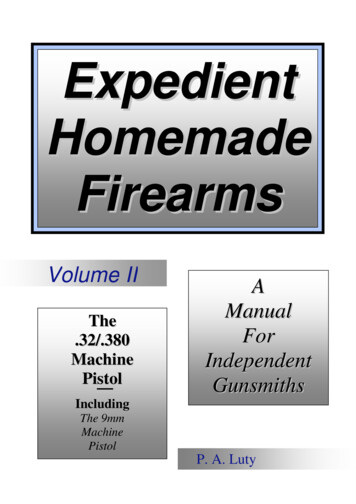
Transcription
Before handling the pistol read this manual carefully and observe thefollowing safety instructions.Improper and careless handling of the pistol could result in unintentional dischargeand could cause injury, death or damage to property. The same consequences can becaused by unauthorized modifications or adjustments, corrosion, or use of non-standardor damaged ammunition. In these cases the manufacturer shall not be responsible in anymanner whatsoever for the resultant consequences. Before leaving the factory this pistolwas tested, carefully inspected, and packed. CZ cannot accept responsibility for producthandling while in transit, or upon leaving the factory. Therefore, please examine this pistolcarefully at the time of purchase to ensure that it is unloaded and undamaged.This instruction manual should always accompany this pistol and that even in thecase of the loan or sale of this pistol.CONTENTSSAFETY INSTRUCTIONSPISTOL DESCRIPTION AND TERMINOLOGYSafety FeaturesOPERATING INSTRUCTIONSAmmunitionRemoval of the MagazineMagazine LoadingPistol LoadingReloading During ShootingUnloading the PistolEngaging the Safety ModeDecockingSight AdjustmentChanging the Back Strap InsertsMAINTENANCE INSTRUCTIONSStripping for Cleaning - DisassemblyMagazine DisassemblyExchange of Control ElementsCleaning the PistolCleaning the Barrel Bore and the Cartridge ChamberCleaning of Other Pistol PartsPreservingWaste ManagementLIST OF PARTSTROUBLESHOOTING, CAUSES AND REMEDIESLIST OF ILLUSTRATIONSADAPTER FOR CZ P-09, CALIBRE .22 LR12566677777888999910101011111112131415
SAFETY INSTRUCTIONSAlways follow the safety instructions for your safety and the safety of others.1. Always handle your pistol as if it were loaded.2. Never point your pistol at anything you do not intend to shoot.3. Never take anyone's word that a gun is unloaded.4. Always make sure that your pistol is not loaded before laying it down, or handing it toanother person.5. Always keep and carry your pistol empty, with the hammer forward except when youintend to shoot.6. Never abuse your pistol by using it for any purpose other than shooting.7. Never leave the pistol cocked and ready to fire unattended.8. Before loading your pistol be sure that the barrel bore, chamber, and action are cleanand clear of obstructions. After shooting, clean the dirtied pistol as soon as possible.9. Always use only clean, dry, original high quality commercially manufacturedammunition, which is appropriate to the caliber of your pistol.10. Never drink alcoholic beverages or take drugs before or during shooting.11. Always wear safety glasses and ear protection when shooting.12. Always keep the safety on when the pistol is loaded and cocked, until you are ready tofire. Keep your pistol pointed in a safe direction when disengaging the manual safety.13. Always keep clear and keep others clear of the ejection port.14. Never squeeze the trigger or put your finger in the trigger guard until you are aiming ata target and ready to shoot.15. Always be absolutely sure of your target, and the area behind it, before you squeezethe trigger. A bullet could travel through or past your target up to several hundredmeters.16. Never shoot at a hard surface such as rock, or a liquid surface such as water.17. Never fire your pistol near an animal unless it is trained to accept the noise.18. Never indulge in "horseplay" while holding your pistol.19. Failure to fire: In case of failure to fire hold the firearm keeping it pointed towards thetarget, or a safe open area and wait 30 seconds. If a hangfire (slow ignition) hasoccurred, the cartridge will fire within 30 seconds. If the cartridge does not fire, ejectthe cartridge and examine it. If the firing pin indent on the cartridge is light, or nonexistent, have the firearm examined by a competent gunsmith.20. Always make sure your pistol is not loaded before cleaning, storing or travelling.21. Always keep and store your pistol and ammunition in separate locked receptacles outof reach and sight of children and untrained people.2
22. Never alter any parts of your pistol as the safety and proper function of your pistolcould be seriously compromised.23. Always be aware that corrosion, use of damaged ammunition, dropping the pistol onhard surfaces or other "coarse treatment" could cause damage you may not see. Ifsomething like this happens allow the pistol to be examined and tested by acompetent gunsmith.RULES OF THE SAFE HANDLING TRITIUM SIGHTSThe tritium sights MEPROLIGHT type ML-17777 for CZ pistols involve a luminous frontsight (tritium radiator of 0,565 GBq activity) and a luminous rear sight (2 tritium radiators of0,444 GBq activity) that is installed at the pistol by means of precision dovetails. Tritium inthe gaseous state (99% HT and 1% HTO) is enclosed in borosilicate glass ampoules with aluminescent element and these ampoules are fixed by glue into the metallic cap of the sightso that the manipulation and storage of the sights is not exposed to any risks.The third generation of the sights retains all the advantageous features of the precedinggeneration of MEPROLIGHT sights and several improvements are added:--built-in shock absorbersolid protective bushing providing less sensitivity against rough manipulationimmovable crystal window for a better light output with additional protectionagainst a damagetolerance against longer immersion in currently used solvents and cleaning agentsguaranteed continuous available light intensity for the period of 12 yearsMV sealing design (the only design tested and approved by Israel armed forces)protects the sights against an accidental damage, avoids the unwantedmanipulation with the light source, inhibits to penetrate the dirt into the visualsystem and to hide the lightprovided a finer transition between the aiming during the day and the nightsimple installation (no modification of the arm is necessary)no added weight nor sizeno maintenanceno battery needed (no losses of the energy at the cold weather)Safety instructions in case of the sights damageIn regular conditions of the storage, use and maintenance there is no risk to the usercaused by emitted ionizing radiation, because it doesn't penetrate metallic caps, in which theampoules with radiators are fixed. In case of a nearly unreal incidental damage of allampoules in one set at the moment, when the arm is in shooting position (position of thesights closer to the shooter), the single effective radiation dose wouldn't exceed the value of0,26 mSv. What does this value present? It is for example:3
-1/12 of the dose which is received by an ordinary inhabitant in course of a yeardue to the natural radioactive background (3,5 mSv / year)less than 1/4 of the general effective dose limit to an ordinary inhabitantRecommended first aid at the inspiration of the gaseous tritiumThe gaseous tritium state is practically inactive and causes a slight internalcontamination. In case of its inspiration it is recommended to increase the intake of liquidsand eventually to take some diuretic (beer with low content of alcohol) for acceleration of thebody water exchange.DUTIES OF THE TRITIUM SIGHTS OWNER1. The sights are a radioactive radiator in the period of 6,5 years since their purchaseaccording to the Czech Republic legislation.2. At the purchase the owner obtains a guide with rules of the safe handling and adocument on the on the impermeability of the radionuclidic radiators in the set(certificate of the encased radionuclidic radiator), which must be preserved andpresented on request of the competent authority.3. When handling a type approved product, which is the source of the ionizing radiation,it is necessary to respect national regulations for protection against he ionizingradiation (the appropriate national legislation).4. In case of the ownership of more than 9 sets of sights (the total activity exceeding 10GBq) the owner is obliged to consult the duties resulting from the appropriate nationallegislation at the competent authority.5. To avoid such manipulation, when a rough mechanical damage of the sights may happen.6. It is not allowed to carry out any changes, relating to the properties of the protectionagainst the radiation.7. In case of the destruction or the damage, the sights mustn't be further used. Theowner is obliged to secure safely the device changed in such a way and to pass it tothe distributor or the manufacturer for the safe liquidation. The same procedure to beapplied for liquidation of no more used sights.8. The manipulation with sights is governed by general principles of the protectionagainst the ionizing radiation. At the current use there are no requested tests ofimpermeability during the service life of the sights.The sights were type approved by the decision of the competent authority Ref. No.25169/2005, index A1.Company, eventually the responsible company representative:Ing. Ladislav Britaňák4
PISTOL DESCRIPTION AND TERMINOLOGYThe names of basic pistol parts used in this Instruction Manual are presented in Fig. 1on the inner side of the left-hand cover. Nomenclature of all CZ P-09 parts are presented inthe section List of Parts.The CZ P-09 pistol is a semi-automatic handgun incorporating short recoil, designed foraimed shooting up to 50 m distances. The CZ P-09 utilizes the locked breech principle. It isfitted with a trigger mechanism adapted to operate both in SA and DA modes of fire, a firingpin safety, safety stop on the hammer and manual safety which can be easily disassembledand substituted by a hammer decocking element. The frame is made from plastic material.Characteristic features of the CZ P-09 are:-Comfortable grip and balance in either handGood results at instinctive shooting (without aiming)Low trigger pull weightHigh accuracy of fireLong service lifeHigh reliability, even with various types of cartridgesSights adapted also for aiming under reduced visibility conditionsThe slide stays open after the last cartridge has been firedSuitable for everyday service gun totingThe standard pistol version provided with ambidextrous safety or ambidextrousdecocking elementMutual interchangeability of the safety and hammer decocking elementThe front part of the frame provided with grooves for applying special accessoriesEach pistol is supplied with these items:--2 pieces of magazines (the number of magazines can differ for particular versionsof the pistol)set of interchangeable back strap insertsinterchangeable control elements (safety/hammer decocking lever controller)maintenance and cleaning instruments (cleaning brush, cleaning rod, key forsights adjustment, polymer case)documents related to the pistol (instruction manual, CD containing promotion filesand instruction manuals in various languages, warranty certificate/card, groupingpaper)padlock (only in selected versions)5
Comments:SA (Single Action)The trigger mechanism operates in a single action mode of fire. The hammer is cockedmanually and then after pressing the trigger the pistol is fired. The trigger travel is short, andpull weight is low. After each discharge the hammer remains cocked.DA (Double Action)The trigger mechanism operates in a double action mode of fire. The hammer iscocked, released and the pistol fired by one pull of the trigger. The trigger travel is longer,and trigger pull weight is higher than at SA mode of fire.Safety FeaturesTrigger GuardPrevents unintentional pressing of the trigger, for example when the pistol is dropped.Inertia Firing PinThe design of the firing pin prevents the firing pin from protruding through the face ofthe slide when the hammer is in its rest position. This eliminates the possibility of a dischargewhen a loaded pistol is dropped on the hammer.Firing Pin SafetyThe firing pin safety keeps the firing pin blocked until the trigger is pulled. This safetydevice minimizes the risk of accidental discharge through mishandling such as when aloaded pistol is dropped.Safety Stop on the HammerA half-cock safety notch is on the hammer so as to prevent it from striking the firing pinwhen the hammer is manually cocked, and a thumb could slip. When the hammer is on thesafety stop, it is not leaning against the firing pin stop, but its position is further back.OPERATING INSTRUCTIONSAmmunitionUse only factory-manufactured ammunition of appropriate caliber, which are incompliance with CIP regulations (International Proof Commission for Firearms) or SAAMI(Sporting Arms and Ammunition Manufacturers' Institute Inc. of the United States). The useof other cartridges could damage the handgun or cause injury to the shooter. Themanufacturer of the firearm does not recommend excessive dry firing (firing withoutammunition). It is advisable to use snap caps for dry training as they are intended for thispurpose.6
Removal of the MagazineGrip the pistol in your right (left) hand and by the thumb (middle finger) depress themagazine catch (Fig. 2). The magazine disengages and falls out of the frame. This pistolmodel is equipped with the user type magazine catch which can be reversed by gunsmith forthe right or left hand operation.Magazine LoadingWith the open end uppermost, grasp the magazine in one hand. Place a cartridge onthe magazine follower. Press the cartridge down and back until it touches the rear flat edgeof the magazine. Place the next cartridge on top of the previous cartridge and press downand back. We recommend that when some cartridges are already loaded in the magazine,depress them slightly with the thumb of the hand which holds the magazine.The number of cartridges can be checked through the inspection holes in the sides ofthe magazine. Do not try to exceed the magazine capacity - doing so can cause a feedingfailure.Pistol LoadingALWAYS MAKE SURE THE PISTOL IS POINTED IN A SAFE DIRECTION WHEN LOADING!Insert a loaded magazine and ensure that it has engaged the magazine catch.Hold the pistol by the grip with one hand, and with the thumb and index finger grasp theserrated finger grips on both sides of the slide. Retract the slide to the stop and allow it tosnap forward (Fig. 3). This procedure cocks the hammer and inserts a cartridge into thechamber. The pistol is now ready to fire. If you do not intend to fire immediately, ensure thepistol safety by some of the methods mentioned in the section: Engaging the Safety Mode oras per section Decocking.Reloading During ShootingWhen the last cartridge has been fired the slide will stay to the rear. Remove theemptied magazine and replace it with a loaded one. Thumb down the slide stop with theshooting hand (Fig. 4), or with the other hand draw back the slide and allow it to snapforward. The pistol is again loaded and ready to fire.Unloading the PistolALWAYS MAKE SURE THE PISTOL IS POINTED IN A SAFE DIRECTION!-Remove the magazineDraw back the slide and verify the last cartridge has been extracted from thechamber and ejectedLet the slide snap fully forwardDepress the trigger (dry fire)7
Engaging the Safety ModeThe version equipped with a decocking device is not covered in this section!Push the safety up to the Safety-On position (Fig. 5) until the red warning dot iscovered. The safety in this position blocks the trigger mechanism and slide, thus preventingthe pulling of the trigger and operating the slide. The safety lever can be set to the "Safe"position even with the hammer on safety notch. However, it is strongly not recommendedthat the safety be engaged while in this state as any forced cocking of the hammer or pullingof the trigger could damage the trigger mechanism and cause unwanted firing even thoughthe safety is in the "Locked" position. The pistol safety shall be only engaged with thehammer in its rear position, i.e. cocked. The use of safety is therefore convenient for shortinterruptions of firing only.Besides the method previously described it is possible to put the pistol into a safetymode and still be ready to fire immediately:Load the pistol. Grasp the grip, POINT IN A SAFE DIRECTION. With thumb press onthe grooved area (thumb piece) of the hammer, pull the trigger and release the hammerslowly ahead (Fig. 6) until it rests on the action or safety thumb of the hammer. Release thetrigger. Practise this operation very carefully to avoid an accidental discharge! We stronglyrecommend to practise this operation beforehand with the pistol unloaded!In this state the pistol is safe for all normal handling and at the same time ready forimmediate use. Please remember that the safest way to secure a pistol is to unload it andstore it in a safe place!DecockingThe version equipped with a manual safety is not covered in this section!MAKE SURE THE PISTOL IS POINTED IN A SAFE DIRECTION and thumb down thedecocking control lever (Fig. 7).Pressing down the decocking control lever actuates the lowering of the hammer fromthe cocked position to the hammer safety notch position, without any need to pull the trigger.Even if there is a cartridge in the chamber the pistol is (hammer decocked) safe for allnormal handling in this state, and ready for immediate use in a Double Action mode of fire.Sight AdjustmentThe pistol sights were sighted in at the manufacturing plant at a distance of 25 mso that the mean point of impact approximately conforms to the point of aim. Windagecorrection can be carried out by the drifting of the rear sight in the dovetail and then securedin its position by screw. Elevation correction is carried out by exchanging the front sight forhigher or lower sizes and by securing with a screw.8
Changing the Back Strap InsertsEach pistol is supplied with a set of changeable back strap inserts, which enables therear part of the grip to be adjusted according to the individual needs of the user. In order tochange the back strap inserts it is necessary to remove the main spring plug pin. To avoidinjuries be very careful when removing the pin as it secures the main spring plug as well asthe compressed main spring. Entrust the task to a gunsmith.MAINTENANCE INSTRUCTIONSStripping for Cleaning - DisassemblyPOINT YOUR PISTOL IN A SAFE DIRECTION!1. Remove the magazine. The pistol must not be disassembled with the magazineinserted!2. Put the safety to "OFF" position, in order to release the movement of the slide.3. MAKE SURE THAT THERE IS NO CARTRIDGE IN THE CHAMBER!4. Retract the hammer slightly back and then release it, until it stops on half-cock (safety)notch position. In this state the handling which follows will be easier.5. Put your left thumb through the trigger guard and with the other fingers grasp the topof the front part of the slide firmly.6. Push the slide slightly rearwards until the rear of the slide is against the retractedhammer and the guidelines on the frame and the slide are in line.7. Push (tap) the slide stop from the right hand side of the weapon, i.e. using themagazine base (Fig. 8). Remove the slide stop from the left.8. Pull the slide and the barrel forward off the frame.9. Remove the recoil spring and finally the barrel.No further disassembly is needed for routine maintenance. When a great number ofcartridges has been fired, it is advisable to also disassemble magazine and to entrust thepistol to a competent gunsmith for the firing pin cleaning.Magazine DisassemblyTo remove the magazine base, push on the base lock which sticks out through a holein the base and slide the base about 5 mm towards the front of the magazine. Cover thebase with your thumb to prevent losing the magazine spring and with the other hand take offthe base from its guiding rails. Be careful during the disassembly as the spring could fly out,or even cause an injury.9
Exchange of Control ElementsThe pistol is designed in such a way that it enables an easy exchange of the safety bythe hammer decocking element and reversely. This operation can be done without using anyspecial tooling. The left safety or left decocking element can be removed first afterdepressing the ejector downward. Before assembling the right safety or right decockingelement it is necessary to depress the trigger bar downward.In the safety configuration only safeties are installed. In case of the decockingconfiguration besides the control elements, it is necessary to install also the spring of thecontrol element so that its shorter end is supported by the nose of the control element bodyand the opposite end is positioned in the pin hollow (Fig. 9).It is recommended to pass the training of the control elements exchange undersupervision by an experienced gunsmith or to refer to the guidance on the website of Ceskazbrojovka.CAUTION:No further disassembly of your pistol is recommended. Should your pistol requireadjustment or repair be sure the task is entrusted to a competent gunsmith!Cleaning the Pistol-Clean the pistolEach time you use itIf you get your pistol wetAs soon as possible after shootingAt least once a year in a temperate climateAs often as once a month in a tropical climate, or other demanding environmentCleaning the Barrel Bore and the Cartridge ChamberIf the pistol has not been fired or if only a few cartridges have been fired, clean thebarrel bore and cartridge chamber by the clean patch attached to the cleaning rod. Repeatthe cleaning, changing patches, until the last patch comes out clean.When the barrel bore is very dirty, apply a gun cleaning solution using a cleaning brush.Let the solvent act for about 10 minutes (this time may vary depending on the solvent agentbeing used). Then thoroughly scrub out the barrel bore. Subsequently, dry the barrel boreand cartridge chamber with a clean patch and check that all powder residues or fouling havebeen removed. If necessary repeat this procedure.The cleaning rod and the brush must be inserted into the barrel bore from the chamber,to prevent wear or damage to the muzzle. Pass the brush all the way through the barrel borebefore reversing the movement. If you try to change directions with the brush in the barrel,the brush could stick.10
Cleaning of Other Pistol PartsOther parts of the pistol (including the external surfaces of the barrel) should becleaned with a dry cloth, old toothbrush, brass bristle brush or a wooden scraper. Preservingoil or paraffin oil can be used for proper cleaning. Never use the agent designed for barrelbore cleaning! These solutions could remain in the joints, and after some time could causecorrosion.Check that cloth particles or brush bristles have not become lodged in any part of thepistol.PreservingWhen the barrel bore, cartridge chamber, and all accessible parts are clean and dry,wipe these parts with a cloth soaked in gun oil or apply the oil in a spray. Remove all excessoil.Before shooting always wipe the barrel bore dry. At very low temperatures remove theoil from all accessible parts or apply a lubricant prepared especially for these conditions.Use thick preserving agents for example, preserving grease only for a long-termstorage in demanding climate environments, and before any use of the pistol it must bethoroughly removed from all parts of the firearm.Waste ManagementWhen used properly, the materials used in the product and packaging have no adverseeffects on human health or the environment. When disposing of the product or its packaging,metal parts (steel and non-ferrous metals), plastics, wood, paper and cardboard should bestored separately in collecting containers intended specifically for that purpose.The Company, reserves the right to make any changes it thinks necessary to improve its models or tomeet any requirements of manufacturing or commercial nature.11
LIST OF PARTS1 a) Frame25 Front Sightb) Changeable Back Strap26 Main Spring StrutInsert S/M/L27 Main Spring Plug2 Slide28 Sear Pin3 Barrel29 Hammer Pin4 Slide Stop30 Trigger Pin5 Magazine31 Magazine Catch Plug6 Insert - Front32 Main Spring Plug Pin7 Insert - Rear33 Extractor Pin8 Trigger34 Magazine Catch Pin9 Trigger Bar35 Insert - Front Pin10 Sear36 Pin11 Hammer37 Firing Pin Plug12 Disconnector38 Recoil Spring Assembly13 Firing Pin Block Lever39 Securing Screw (2x)14 Trigger Bar Disconnector40 Extractor Spring15 Ejector41 Firing Pin Spring16 Firing Pin42 Firing Pin Block Stop Spring17 Extractor43 Spring (2x)18 Firing Pin Block Stop44 Slide Stop Spring Pin19 Magazine Catch45 Main Spring20 Safety - Left *46 Trigger Spring21 Safety - Right *47 Slide Stop Spring22 Hammer Decocking Lever48 Hammer Decocking Lever Spring *Controller - Left *49 Trigger Bar Spring23 Hammer Decocking Lever50 Sear SpringController - Right *51 Insert - Rear Pin24 Rear Sight *The parts marked * differ according to versions, or as case may be in some versionsare entirely missing.12
TROUBLESHOOTING, CAUSES AND REMEDIESIf your pistol is properly used and maintained, malfunctions will rarely occur. However, ifsuch a situation does occur, please observe the following instructions.CAUTION - If a malfunction occurs, the possibility of unintentional discharge issubstantially increased. For this reason, carefully observe the Safety Instructions alreadymentioned above. Keep the pistol pointed in a safe direction, do not turn the pistol againstyour body or anyone else’s! Do not place your hands in front of the barrel!If you use your pistol for self-defense, or in law enforcement, please acquire so-called“dummy cartridges” and practice fast clearing of malfunctions as described below.MalfunctionPossible CauseRemedyMagazine is not fullyinserted or is damaged.Insert magazine properly or changemagazine.The pistol or cartridges arefouled (dirty) or too heavilygreased.Clean the pistol and cartridges andwipe them dry or as case may beslightly lubricate.Defective cartridge.Pull the trigger again. If a discharge isnot initiated, follow the SafetyInstructions according to point 19.MisfireFiring pin hole fouled(dirty) or unproperlubrication agent usedunder low temperatureconditions.Disassemble and clean the firing pinor use a low temperature lubricant.A shot sounds "weak"combined with failureto eject the cartridgecaseThe cartridge has beenactivated but no powderload was inside thecartridge case.Unload the pistol and check that thebullet is not lodged in the barrel. Asubsequent shot could causedamage to the barrel.The spent case hasnot been ejectedCartridge chamber,extractor or ammunitiondirty, or unsuitablelubricant in lowtemperature environment.Clean and wipe the pistol dry orlubricate lightly with a suitable agent.Use new and clean ammunition.A cartridge has notbeen fed into thechamber or the slidehas not fully lockedwith the barrelIf you cannot clear away any malfunction in the manner described above, entrust thepistol to a competent gunsmith for inspection and repair.13
LIST OF ILLUSTRATIONS1. The names of basic parts2. Removal of the magazine3. Pistol loading4. Slide release from its "rear lock-up" position by depressing slide stop5. Shifting the safety to the "SAFETY-ON" position6. Release of the hammer in the version equipped with the manual safety7. Release of the hammer in the version equipped with no manual safety8. Slide stop removal using the magazine base9. Detail of the hammer decocking element installed14
ADAPTER FOR CZ P-09, CALIBRE .22 LRAdapter for the CZ P-09 pistol in calibre .22 LR can be supplied in the following twoversions:1. The adapter itself, which can be mounted on a frame of any CZ P-092. Complete CZ P-09 pistol in calibre .22 LRThe main benefits of the adapter are:-retaining the typical characteristics of the CZ P-09 pistol-economy of firing - advantageous especially for trainingeasy installation of the adapter on the frame without the necessity of additionalalignmentInstallation of the .22 LR adapterNo modifications or additional alignment are necessary for the use of the .22 LRadapter on an existing pistol. Follow the instructions in Stripping for Cleaning - Disassemblyand remove the existing slide assembly and mount the .22 LR adapter on the pistol frame.The supplied slide stop marked as "22 LR" and a magazine in calibre .22 LR must be usedwith the adapter.15
Illustration and list of parts for the .22 LR adapter2 Slide33 Extractor pin3 Barrel37 Firing pin plug16 Firing pin38 Recoil spring (assembly)17 Extractor40 Extractor spring18 Firing Pin Block Stop41 Firing pin spring24 Rear sight42 Firing Pin Block Stop Spring25 Front sight52 Front Sight Screw53 Securing screw16
ammunition, which is appropriate to the caliber of your pistol. 10.Never drink alcoholic beverages or take drugs before or during shooting. 11.Always wear safety glasses and ear protection when shooting. 12.Always keep the safety on when the pistol is loaded and cocked, until you are ready to fire.


